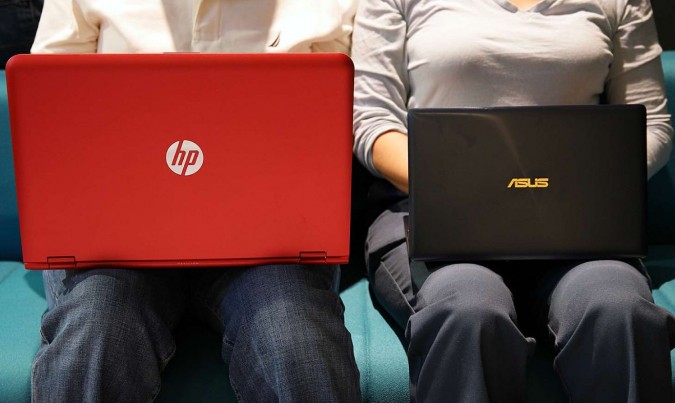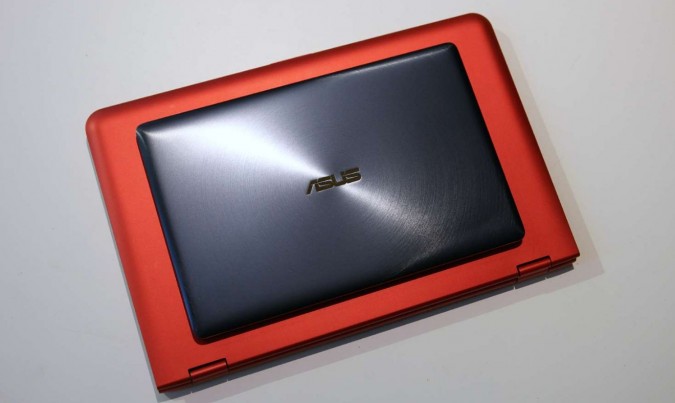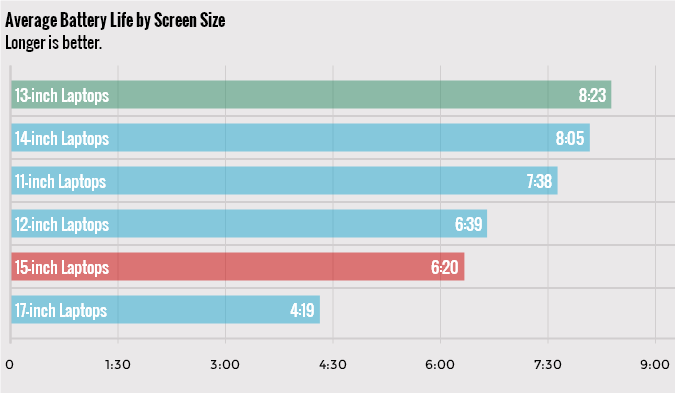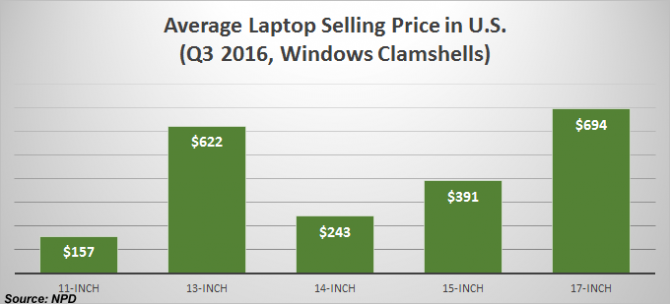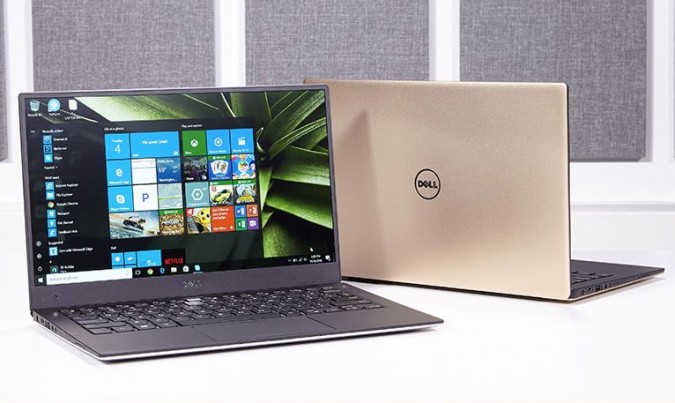Why You Shouldn't Buy a 15-inch Consumer Laptop
Pundits sometimes talk about the "wisdom of crowds," but just because something is popular that doesn't mean that it's good. Like the Twilight saga of the PC industry, 15-inch consumer laptops outsell all other sizes by a wide margin, but shoppers should avoid them like a sparkly vampire with control issues.
According to research firm NPD, 68.1 percent of Windows clamshell laptops sold have 15-inch screens, dwarfing the more portable 14-inch (9.4 percent), 13-inch (2.4 percent) and 11-inch (10 percent) sizes. These 15-inchers also make up a plurality of 2-in-1s, grabbing 39.8 percent of that market, which is significantly more than the portions occupied by 13-inch (30.6 percent), 14-inch (8.9 percent) and 11-inch competitors (15.4 percent).
Mainstream consumers like 15-inch laptops, both because they like having a larger screen to stare at and because this size class usually gives you more performance for the money.
"Consumers value screen size above else and have for many years," said NPD analyst Stephen Baker. "For the amount of portability most consumers want, 15 inch[es] offers them plenty."
MORE: Best Ultrabooks (Thin-and-Light Windows Laptops)
Unfortunately, many home users don't understand the benefits of having a laptop they can carry around and use unplugged. Most mainstream 15-inch laptops are too large to fit comfortably on your lap and are too heavy to lug around all day. The average 15-incher weighs a portly 5 pounds, which will weigh down your legs or the crook of your arm. By contrast, an average 14-inch laptop is 3.7 pounds or less, while a 13-inch system is usually 3.2 pounds or less.
Even if your laptop never leaves the house, you should be able to balance it on your lap (hence the name "laptop") or place it on a small table or nightstand. If you can't move your computer around the house, it's a compact desktop, not a notebook.
Sign up to receive The Snapshot, a free special dispatch from Laptop Mag, in your inbox.
If you really want the large-screen experience you get from a desktop computer, why not just buy an external monitor (or two) that you can connect to your laptop when it's on your desk? A 23-inch, full-HD display is much bigger than even the largest notebook screen, and you can buy a decent one for less than $150. Then, you can have the best of both worlds: a huge workspace when you want it and a portable computer when you need it.
If you can't easily move your computer, why are you buying a laptop in the first place?
You may have electric outlets in every room, but that doesn't mean you don't need long battery life. Remaining physically tethered to the wall makes your laptop a lot less convenient. Do you really want to be limited to the right side of the couch, the back end of the table or your partner's side of the bed, because those spots are next to the sockets? And what happens when your toddler or your dog trips over the cord, and brings your $600 investment crashing onto the floor?
Among all 15-inch laptops we've run the Laptop Mag Battery Test on since 2015, the average battery life is just 6 hours and 20 minutes, and that number drops to a mere 5 hours and 48 minutes when only sub-$600 laptops, the most common price range, are included. By comparison, the average 13-inch laptop lasts 8.5 hours on our test, while the typical 14-incher endures for 8 hours.
Five or six hours of endurance may not sound that bad on paper, but it's important to note that our benchmark measures a low-power scenario, surfing the web via Wi-Fi at 100 nits of brightness (usually 40 to 50 percent). If you pump up the brightness, start multitasking or play games, your computer will die a lot sooner.
Laptop manufacturers and resellers deserve a lot of blame for the 15-inch laptop's misguided popularity. Whether you walk into a brick-and-mortar store or browse a website, you'll find a disproportionate number of low-cost laptops that have 15-inch screens.
According to NPD data, the average 15-inch clamshell laptop (with Windows) costs $391, compared to $622 for the typical 13-inch clamshell. However, the average 14-inch laptop, which is a lot more portable despite having just 1 inch less display space, runs just $243. For all laptop sizes, 2-in-1s cost a bit more, averaging $724, $565 and $773 for 15-, 14- and 13-inch screen systems, respectively.
However, if you know where to look, you can find a very portable laptop for well under $600. The Asus VivoBook E403SA has a 14-inch screen, weighs just 3.2 pounds, has an attractive aluminum chassis and gets over 9 hours of battery life. The Lenovo ThinkPad 13 starts at $584, weighs just 3.1 pounds and also lasts over 9 hours on a charge. Neither one has the fastest processor — although you can get the ThinkPad with a Core i5 if you pay extra — but both will be more than adequate for price-conscious shoppers.
As you increase your budget, you can get even lighter and more powerful laptops, such as the 2.7-pound Dell XPS 13, which starts at $799 and lasts 14 hours on a charge.
Who should get a 15-inch laptop?
There are many people who really do need a 15-inch laptop, but they're not spending $400 on the latest sale item at Best Buy. Creative professionals, gamers and power-hungry business users need 15-inch or larger laptops because they require power-hungry components such as quad-core CPUs and high-end discrete graphics cards that just won't fit in a smaller chassis.
When you're a professional animator, videographer or engineer, it's worth carrying a heavier computer to get the performance you need and to be able to see more on-screen. You might really need to bring that 6-pound workstation on location when you're filming a movie or drilling for oil. But when you're in a profession that requires this kind of computing power, you or your company will be more than willing to pay premium prices for a laptop. You can even get a relatively light 15-inch laptop, such as the 4-pound Dell XPS 15, if you can afford to spend over $1,000.
Many gamers are also more than willing to spend thousands of dollars to get the kind of performance they need. Considering that some people still use bungee cords to carry their towers to gaming parties, a 5.5-pound laptop seems rather light.
Bottom line
If you're not a power user or a gamer, you should strongly consider a 12-, 13- or 14-inch laptop. The difference in weight and battery life between a 15-inch laptop and one with a smaller display is the difference between being able to carry your computer around the house (or around the world) and having to leave it on a table near an outlet at all times. And if you can't easily move your computer, why are you buying a laptop in the first place?
*- Weight averages are based on notebooks tested by laptopmag.com between Jan. 1, 2015, and Oct. 31, 2016.
Laptop Guide
- Laptop Buying Guide: 8 Essential Tips
- The Best & Worst Laptop Brands
- Laptop Tech Support Showdown: Undercover Report
- Should I Buy a Chromebook? Buying Guide and Advice
- Laptops with the Longest Battery Life
- Chromebooks vs. Windows 10 Laptops: What Should You Buy?
- Why You Shouldn't Buy a Touch-Screen Laptop
- Out of the Box Tips: Set Up Your New Laptop Like a Pro
- The Best Time to Buy a Laptop
- Chromebook vs. Tablet: Which Should You Buy?
- Laptop Buying Tips for Students
- 10 Key Features to Look for in Your Laptop
- How to Buy a 2-in-1 Laptop Hybrid
- USB Type-C FAQ: Everything You Need to Know
- How to Get Rid of Your Old Laptop
- Laptop Warranties: What They Cover
- Which CPU is Right For You?
- Which Laptop Features Are Worth the Money?
- Gaming Laptop Buying Guide: Find the Right Rig
- 10 Reasons Why Consumers Should Buy Business Laptops
- Which MacBook is Right for You?
- 5 Things to Look For in Your Next Laptop Keyboard
- How to Configure Your Laptop: Specs That Matter
- Which Graphics Card Do You Need?
- The Perfect Laptop? Here’s What It Should Have
- Why 78 Percent of Laptop Screens Suck
- A Guide to Computer Ports and Adapters
- 13 Ways to Make a Slow Laptop Faster
- How to Tell If You Can Upgrade Your Laptop
- Laptop Locks Guide: Do You Need One?
- 10 Features You Can Skip to Save Money

